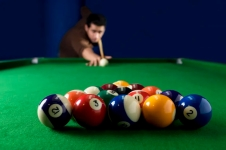Billiards, an elegant and interesting sport, has attracted many beginners who are eager to have a try. However, when first stepping into the field of billiards, beginners often encounter various “pitfalls”. In order to help you start your billiards journey smoothly, please keep this guide to avoid pitfalls, and let Spike lead you into the world of billiards.

##Don’t Be Blind in Equipment Selection
For beginners, it is crucial to avoid blindly following the trend when choosing equipment. Many people want to buy an expensive cue right from the start, believing that the more expensive it is, the better. In fact, the price range of billiard cues is extremely wide, ranging from dozens of yuan to tens of thousands of yuan. When beginners start playing billiards, their techniques are not yet fixed, and they lack sufficient understanding of the characteristics and feel of the cue. At this time, it is more appropriate to choose an entry-level cue priced at around 200 – 500 yuan. This kind of cue offers high cost-effectiveness, can meet basic shooting needs, and helps beginners get familiar with the use of the cue. At the same time, when choosing a cue, pay attention to its weight and elasticity. Generally speaking, male beginners can choose a cue weighing 18 – 20 ounces, while female beginners can choose one weighing 16 – 18 ounces. The elasticity of the cue should be moderate, as a cue that is too hard or too soft is not conducive to beginners controlling the hitting force. When choosing a billiard table, you can select one with a flat playing surface and smooth ball movement. Spike billiard tables use Grade A Qing stone slabs from Jiujiang. The playing surface is flat and the ball path remains unchanged. The cushions are made of imported high-elastic cushions from the north, which have good resilience. They are competition-level billiard tables and are also very suitable for beginners to practice on.
##Standardize the Basic Posture
A standardized basic posture is the key to playing billiards well, which is exactly what many beginners tend to overlook. In terms of the standing position, taking holding the cue with the right hand as an example, the feet should be shoulder-width apart, the right foot should be on the extension line of the cue ball, and the left foot should be slightly stepped forward to the left front. The body should be slightly tilted forward, and the center of gravity should be between the two feet, which can ensure the stability of the body when hitting the ball. Many beginners either have their feet too close together or too far apart when standing, resulting in an unstable center of gravity and making it easy to shake when hitting the ball, affecting the accuracy. The grip posture is also very important. Common grip methods include the front-hand grip and the back-hand grip. In the front-hand grip, the index finger and thumb encircle the cue, which is suitable for players who are used to using wrist force for cue techniques. However, it is more difficult for beginners to master and they are likely to have the problem of gripping the cue too tightly. In the back-hand grip, the middle finger and thumb encircle the cue, which is easier to get the hang of and is suitable for beginners who pursue accuracy. Beginners should find the most suitable grip posture for themselves through continuous practice.

## Don’t Ignore the Hitting Techniques
When hitting the ball, one of the common mistakes made by beginners is improper force application. Many people rely solely on the strength of their arms to hit the ball, which is not only laborious but also difficult to control the force and direction of the hit. The correct way to apply force is to use the overall strength of the body, with the upper arm driving the lower arm, and transfer the force to the cue at the moment of hitting the ball. When hitting a long-distance ball, you should also learn to use the strength of the abdomen to reduce the burden on the arms and wrists and make the shot smoother. In addition, the rhythm of the cue movement cannot be ignored. When moving the cue, the front and back tracks of the cue should coincide with the ball’s exit line, and the speed of the cue movement should be stable, not too fast or too slow. Beginners can first practice slow cue movements to feel the movement state of the cue in their hands and gradually find the rhythm suitable for themselves. Before hitting the ball, pause appropriately for 1 – 2 seconds to prepare both the body and mind, and then make a smooth shot, which can effectively improve the accuracy of the shot.
## Mental Adjustment Is Crucial
When playing billiards, the mental state has an important impact on performance. Beginners are often prone to nervousness, especially when there are others watching or when competing with others. Nervousness can cause the body to become stiff, affecting the smoothness and accuracy of the hitting action. You should learn to adjust your mental state, regard each shot as a practice, focus on the process of hitting the ball, and not care too much about the result. Before hitting the ball, take a few deep breaths, relax your body, and tell yourself to follow the rhythm and movements of your usual practice. At the same time, don’t be discouraged by consecutive mistakes. Billiards is a sport that requires continuous practice and experience accumulation, and every mistake is an opportunity for growth. As long as beginners avoid these common “pitfalls” in terms of equipment selection, basic posture, hitting techniques, and mental adjustment when playing billiards and keep practicing, they can gradually improve their billiards skills, defeat their friends, and enjoy the infinite fun brought by this sport.

@spk.billiard
